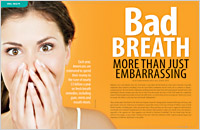You probably think that brushing your teeth is something you already know how to do. After all, isn’t how to brush your teeth something we all learn when we are very young? But you might be surprised — misconceptions on how to properly brush teeth are all too common. Some people may have been taught something wrong when they were a kid. In other cases errors crept in over the years. Whatever the case, making sure you really know how to brush your teeth is worthwhile. Here are the ten steps to follow.
For most people, a soft-bristled toothbrush will be the safest choice. Depending on how vigorously you brush your teeth and the strength of your teeth, medium- and hard-bristled brushes could actually damage the gums, root surface, and protective tooth enamel. Don’t use a toothbrush featuring natural bristles, since they can retain bacteria. The brush head must be small enough to reach all your teeth. Choose a toothbrush with a handle that fits your hand comfortably.
A great toothbrush won’t stay that way for long. A toothbrush will typically have to be thrown out after just a few months of use. Watch for signs the bristles are becoming worn out. If the bristles are frayed and no longer stand up straight it’s time to get a new toothbrush.
Break down biofilm with PerioRenew
Unhealthy gums can dramatically impact more than just your smile. Learn more about this revolutionary new gel for gum disease.
sponsored ad
Brushing just once a day is massively better than not at all, but twice a day is what is really needed. Food can form into plaque in just eight hours, which means that brushing just once per day guarantees lots more plaque on your teeth.
You must use a toothpaste that has fluoride in it. Fluoride both removes plaque and strengthens tooth enamel. Toothpaste brands offer a wide variety of features, such as whitening, desensitizing, and tartar control, as well as different flavors. Choose whatever brand matches your preference.
First, apply just a pea-sized amount of toothpaste. Rather than moving across your teeth, you should brush with small circular motions. Hold your brush at a 45° angle while brushing the front of your teeth. Clean the insides of your teeth by opening wide and angling your toothbrush toward the gum line.
Brushing your teeth energetically does not mean you are doing a better job of cleaning. In fact, vigorous brushing can damage both tooth enamel and gums. Toothbrushes that become worn out very quickly is a strong sign you are brushing too hard.
Brushing too quickly is a common mistake, since cleaning your teeth can be boring. Work your way slowly around your mouth, spending at least ten seconds on every area. Overall, you should spend about three minutes brushing your teeth.
Yes, your toothbrush isn’t just for your teeth. The bacteria that grow on the tongue are hard to remove. Mouthwash is not effective, so brushing is necessary. Simply brush your entire tongue with fresh toothpaste, reaching as far as is comfortable into your mouth.
After you’ve finished brushing, your toothbrush will have lots of nasty bacteria on it. If you don’t clean your brush, you will simply reintroduce those bacteria the next time you try to clean your teeth. Wash your toothbrush under the tap for a few seconds, then set it somewhere to dry out.
Flossing is the component of cleaning your teeth that is most often left out. Don’t make this mistake. As effective as teeth brushing is, it can’t do the job entirely on its own. Small bits of food debris get stuck between the teeth, and flossing is the only way to remove them. Floss between all your teeth at least once a day.
Brushing your teeth is essential to oral health. Tooth problems can be both costly and painful. Teeth brushing is the only way to remove the bacteria that makeup plaque, which if left undisturbed will cause cavities and gum disease. The importance of teeth brushing is why it’s such a good idea to make sure you are truly brushing your teeth correctly.
 Bad Breath – More Than Just Embarrassing
Bad Breath – More Than Just Embarrassing
The bane of humans for thousands of years, bad breath may be no more than the result of poor oral hygiene – or a sign of a more serious, underlying condition. Get the facts on what causes bad breath, and what you can do about it… Read Article
Source: Ten Steps to Brushing Your Teeth

